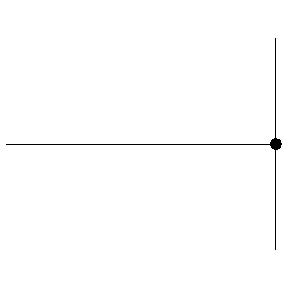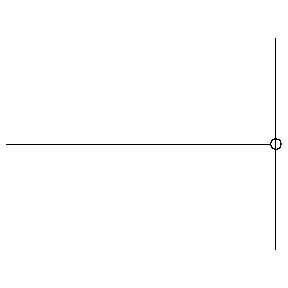Reflection from an impedance discontinuity
When a wave encounters a boundary which is neither rigid (hard) nor free (soft) but instead somewhere in between, part of the wave is reflected from the boundary and part of the wave is transmitted across the boundary. The exact behavior of reflection and transmission depends on the material properties on both sides of the boundary. One important property is the
characteristic impedance of the material. The characteristic impedance of a material is the product of mass density and wave speed, \(Z = \rho c\). If a wave with amplitude
ξ1 in medium 1 encounters a boundary with medium 2, the amplitudes of the reflected wave is given by
$$ \xi_r = {Z_1 - Z_2 \over Z_1 + Z_2}\xi_1 $$
and the amplitude of the wave transmitted into medium 2 is given by
$$ \xi_2 = {2 Z_1 \over Z_1 + Z_2}\xi_1 $$
In the animations below, two strings of different densities are connected so that they have the same tension. The density
μ of the thick string is 4 times that of the thin string.
- If the speed of waves on a string is related to density and tension by \( c = \sqrt{T/\mu} \) how do the wave speeds compare for the two strings?
From high speed to low speed (low density to high density)
In this animation the incident wave is travelling from a low density (high wave speed) region towards a high density (low wave speed) region.
- How do the amplitudes of the reflected and transmitted waves compare to the amplitude of the incident wave?
- How do the orientations of the reflected and transmitted waves compare to the orientation of the incident wave? (upright or inverted?)
- How do the widths of the reflected and transmitted waves compare to the width of the incident wave?
From low speed to high speed (high density to low density)
In this animation the incident wave is travelling from a high density (low wave speed) region towards a low density (high wave speed) region.
- How do the amplitudes of the reflected and transmitted waves compare to the amplitude of the incident wave?
- How do the orientations of the reflected and transmitted waves compare to the orientation of the incident wave? (upright or inverted?)
- How do the widths of the reflected and transmitted waves compare to the width of the incident wave?
 This work by Dan Russell is licensed under a Creative Commons Attribution-NonCommercial-NoDerivatives 4.0 International License.
This work by Dan Russell is licensed under a Creative Commons Attribution-NonCommercial-NoDerivatives 4.0 International License.



